Hello (soon to be) friends...
EDIT: Current Tank (10/12/24):
 After decades of wanting one, I have finally started a saltwater fishtank and am excited for the adventure ahead.
After decades of wanting one, I have finally started a saltwater fishtank and am excited for the adventure ahead.
I've also spent a few hours in two different local fish stores picking their brains. I'm trying to trust and take their advice as much as I can, knowing I'm in the very early stages of the Dunning-Kruger curve and trying to accept expertise when it runs contrary to my naïve intuition.
But enough about that....the first tank.


This was one of many "we're over-solving problems we don't even have yet" instances as we get started....



LFS sold us 90# of Indonesian Live Rock (covered in wet newspaper when arrived) and 90# aragonite sand. He let us take home an extra 25# of rock and just return whatever we didn't use. Got everything in, felt good, sent a pic to LFS...


....and he said we used about 2/3 of the rock that we needed and should add more (first attempt likely only put about 60# in).
So we tore everything apart, emptied the sand, put the water back into buckets and rebuilt in a morning:

That meant instead of everything sitting for 3 days before going back, it only sat for the morning. LFS wasn't bothered by that and still encouraged us to put in the first round of fish as the live rock was ready to go.
I tossed the extra rubble from the live rock into the return chamber of the pump. Is this a terrible idea?

SG: 1.020
Nitrate: 25
KH: 7.0
Our initial plan after watching all the videos was to buy 2 Clownfish.... but LFS also encouraged to pick up 2 Blood Red Fire Shrimp. I'll confess I was distracted talking to the assistant about how to drip-acclimate the Clowns and did not realize we were getting the Shrimp until they were in a bag...but here we are!

The clowns in the pic are pretty representative of their days....the smaller hangs out up top facing down, while the larger one hangs out slightly below just chilling. I thought current might be too high, but when we turn off pump/waves to feed...they stay doing the same thing.
SG: 1.024 (Milwaukee Refractometer) (slowly raising to 1.025 from 1.023 via replacing evaporation with saltwater & doing 5gal 1.025 water change/day)
pH: 8.1 (API Test Kit)
Ammonia: 0 (API Test Kit)
Nitrite: 0 (API Test Kit) (today's bumped up a little for the first time)
Nitrate: ~40 (API Test Kit & Salifert Test Kit)
KH: 8 (Salifert Test Kit)


But for the most part, the larger clown swims around in the back, the smaller clown hangs out in the corner with his face pointing down.
The two shrimp have taken up residence on either side of the tank. They come out to feed and occasionally can be seen popping their heads farther out of the caves they've made.
It seemed like the takeaway from the BRS "Ugly Stage" Series (which DESPERATELY needed a conclusion video...) was that copepods early can really help a tank navigate the "Ugly Stage" well. So I have a bottle of those in the fridge waiting for the first appearance of algae & then they'll get installed.
Looking forward to adding a CuC at some point in the near future once there's enough to be cleaned up.
Eventually more fish and softy/SPS corals!
The deal with my family was they get to pick out all the fish / corals / etc, so am looking forward to seeing what they put in!
I understand the #1 thing in this hobby is _patience_. We already feel like we're going to fast having 2 shrimp + the fish, and are hoping that wasn't a mistake.
The
We have kept bees for the last few years. Something we've taken away from that is that, for the most part, the bees will figure it out....except when they can't. Learning what warrants a response vs "letting it ride" has been a challenge. And, with bees, staying ahead of the disease vector (mites) is the key to success...the unseen problems turn into collapses unless actively testing and treating.
Our "bee mentor" advice was three-fold:
I'd be interested to hear how much that translates to keeping fish. Unlike with bees, we're creating an artificial habitat and an unnatural environment. Does it ever become "stable"? It seems like the most frequent intervention for fish is water changes. Maintaining a regular cadence of changes and knowing when to do a more dramatic change seems to be the advice most distributed.
So, thanks in advance for your thoughts and feedback....looking forward to a great experience and learning tons!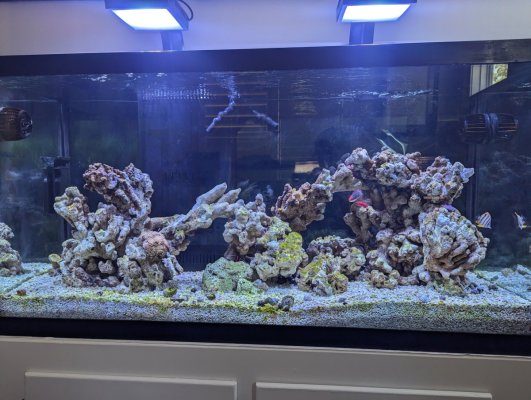
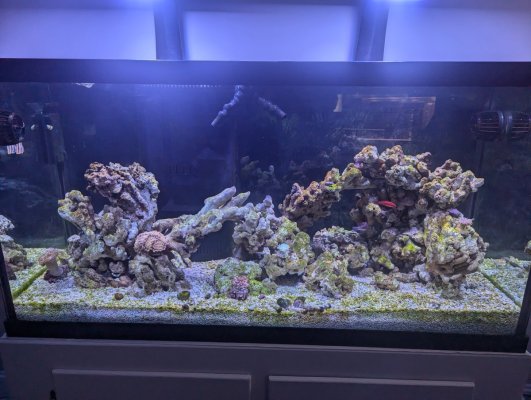
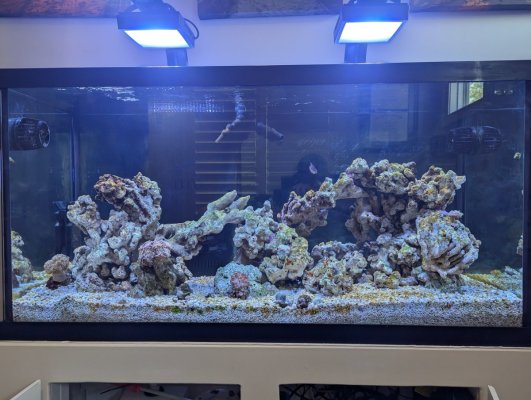
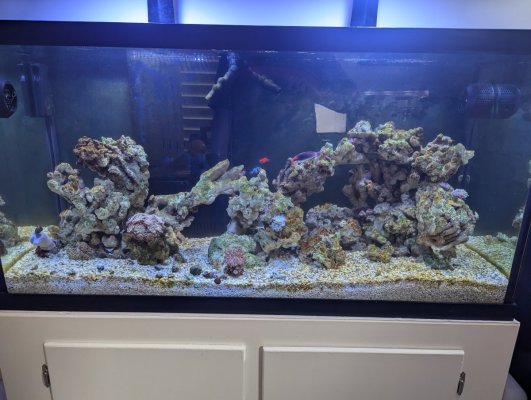
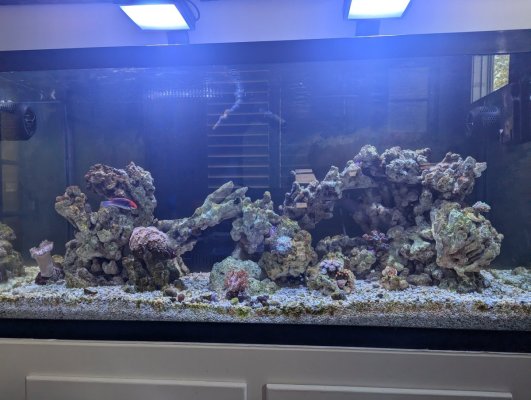
EDIT: Current Tank (10/12/24):
Background
As a point of background...I'm an overthinker. So to prep, I watched the 52 weeks of "My First Fishtank" from BRSTv. Also watched a host of other videos from BRSTV....their 5 minute series, the recent videos from Reef-Palooza, and the 11 part series on avoiding the Ugly Stage (which desperately needed a 12th part with the final conclusions....)I've also spent a few hours in two different local fish stores picking their brains. I'm trying to trust and take their advice as much as I can, knowing I'm in the very early stages of the Dunning-Kruger curve and trying to accept expertise when it runs contrary to my naïve intuition.
But enough about that....the first tank.
Tank
- Initial 90 gal tank + (21 gal?) sump purchased used. (Sump is 12"x24" with 3 compartments, which seems to line up with 21 gal versions online)
- Lighting is a long LED bar, but I can't tell any branding...a circle with waves in it? LFS suggested it will be inadequate for coral and will need to be replaced in the near future.
- Wavemakers did not come with initial setup, so was encouraged to buy 2x Vortech MP40 from LFS for future expansion
- Return pump is 1500gal/hr from Aquatec
- Sump includes filter socks & Bubble Magus Curve-5 Protein Skimmer
- Asked LFS for ATO system and he recommended a Versa VX-1 Peristatic Dosing Pump to do RODI topoff (not installed yet, as I'm still raising salinity)
Water & Mixing!
I grabbed a RODI filtration system off BRS. Connected to the hose bib, it only gets about 35 PSI. LFS recommended a pump and sold me a used 65 gal container with low/high auto on/off system already installed in it. Thing thing has been the bane of my existence so far as I can't figure out how to plug an extra drain (pictured) and the AC transformer blew on it already. My initial intent was to just use 2 Brute trashcans....and I think I'm going to just do that for a while.This was one of many "we're over-solving problems we don't even have yet" instances as we get started....
Installation
After bringing home the tank & stand (used), my wife declared the stand was ugly and I got to learn how to build a fish tank stand. This thing could hold a small car, I'm pretty sure. (doors are made, but not yet attached....I'm sure I'll do a lovely job getting those things square & level....)LFS sold us 90# of Indonesian Live Rock (covered in wet newspaper when arrived) and 90# aragonite sand. He let us take home an extra 25# of rock and just return whatever we didn't use. Got everything in, felt good, sent a pic to LFS...
....and he said we used about 2/3 of the rock that we needed and should add more (first attempt likely only put about 60# in).
So we tore everything apart, emptied the sand, put the water back into buckets and rebuilt in a morning:
That meant instead of everything sitting for 3 days before going back, it only sat for the morning. LFS wasn't bothered by that and still encouraged us to put in the first round of fish as the live rock was ready to go.
I tossed the extra rubble from the live rock into the return chamber of the pump. Is this a terrible idea?
Starting Fish
Took a bag of water, LFS tested:SG: 1.020
Nitrate: 25
KH: 7.0
Our initial plan after watching all the videos was to buy 2 Clownfish.... but LFS also encouraged to pick up 2 Blood Red Fire Shrimp. I'll confess I was distracted talking to the assistant about how to drip-acclimate the Clowns and did not realize we were getting the Shrimp until they were in a bag...but here we are!
The clowns in the pic are pretty representative of their days....the smaller hangs out up top facing down, while the larger one hangs out slightly below just chilling. I thought current might be too high, but when we turn off pump/waves to feed...they stay doing the same thing.
Current Water Parameters:
SG: 1.024 (Milwaukee Refractometer) (slowly raising to 1.025 from 1.023 via replacing evaporation with saltwater & doing 5gal 1.025 water change/day)
pH: 8.1 (API Test Kit)
Ammonia: 0 (API Test Kit)
Nitrite: 0 (API Test Kit) (today's bumped up a little for the first time)
Nitrate: ~40 (API Test Kit & Salifert Test Kit)
KH: 8 (Salifert Test Kit)
Fish Behavior
Both clowns have been feeding regularly; shrimp came out to be fed this afternoon, which LFS #2 suggested was the sign of things going ok. He said Nitrates were a little high, and if the Shrimp stop coming out to eat, do a more aggressive water change of 10-20% to bring down Nitrates.But for the most part, the larger clown swims around in the back, the smaller clown hangs out in the corner with his face pointing down.
The two shrimp have taken up residence on either side of the tank. They come out to feed and occasionally can be seen popping their heads farther out of the caves they've made.
What's Next?
It seemed like the takeaway from the BRS "Ugly Stage" Series (which DESPERATELY needed a conclusion video...) was that copepods early can really help a tank navigate the "Ugly Stage" well. So I have a bottle of those in the fridge waiting for the first appearance of algae & then they'll get installed.
Looking forward to adding a CuC at some point in the near future once there's enough to be cleaned up.
Eventually more fish and softy/SPS corals!
The deal with my family was they get to pick out all the fish / corals / etc, so am looking forward to seeing what they put in!
Parting Thoughts:
I don't know what I don't know. And even what I do know, I likely only understand bits and pieces of it. Very happy to hear your thoughts and feedback.I understand the #1 thing in this hobby is _patience_. We already feel like we're going to fast having 2 shrimp + the fish, and are hoping that wasn't a mistake.
The birds fish and the bees:
We have kept bees for the last few years. Something we've taken away from that is that, for the most part, the bees will figure it out....except when they can't. Learning what warrants a response vs "letting it ride" has been a challenge. And, with bees, staying ahead of the disease vector (mites) is the key to success...the unseen problems turn into collapses unless actively testing and treating.Our "bee mentor" advice was three-fold:
- Bees don't read books --- they're going to do what they're going to do, even if you're trying to get them to do something else. Know and understand "normal" behavior, but don't be surprised when they don't do it.
- The best action to take is usually "wait a week". Somethings things are going wrong....let the bees regain their balance before trying to fix it for them all the time.
- We must actively test and treat for mites or else disease will run rampant and destroy the hive.
I'd be interested to hear how much that translates to keeping fish. Unlike with bees, we're creating an artificial habitat and an unnatural environment. Does it ever become "stable"? It seems like the most frequent intervention for fish is water changes. Maintaining a regular cadence of changes and knowing when to do a more dramatic change seems to be the advice most distributed.
So, thanks in advance for your thoughts and feedback....looking forward to a great experience and learning tons!





Last edited:


















